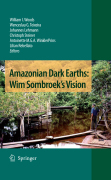
Amazonian dark earths: wim Sombroek's vision
Woods, W.I.
Teixeira, W.G.
Lehmann, J.
Steiner, C.
Amazonian soils are almost universally thought of as extremely forbidding. However, it is now clear that complex societies with large, sedentary populations were present for over a millennium before European contact. Associated with these are tracts of anomalously fertile, dark soils termed ‘terra preta’or dark earths. These soils are presently an important agricultural resource within Amazonia and provide a model for developing long-term future sustainability offood production in tropical environments. The late Dutch soil scientist Wim Sombroek (1934-2003) was instrumental in bringing the significance of these soils to the attention of the world over four decades ago. Wim saw not only the possibilities of improving the lives of small holders throughout the world withsimple carbon based soil technologies, but was an early proponent of the positive synergies also achieved in regards to carbon sequestration and global climatic change abatement. Carbon sequestration Sustainable tropical soil management Forgotten Amazonian Indian technologies of soil management A unique collection of Terra Preta research A vision for the future of tropical soil management INDICE: From the contents Dedication 1. Dr. Wim G. Sombroek. Dedication 2.Thanks. Wim. Foreword - A Few Words about Wim Sombroek. 1 Discovery and Studyof Amazonian Dark Earths: The PreSombroek Period (1870-1959). 2 PreEuropean Continuity and Change in the Central Amazon. 3 Phytoliths and Terra Preta: The Hatahara Site Example. 4 Anthropogenic Dark Earths of the Central Amazon Region: Remarks on their Evolution and Polygenetic Composition. 5 Steps Towards an Ecology of Landscape: The Pedo-Stratigraphy of Anthropogenic Dark Earths. 6 AnAssessment of the Cultural Practices Behind the Formation (Or Not) of Anthropogenic Dark Earth in Marajó Island Archaeological Sites. 7 Kayapo Savanna Management: Fire. Soils. and Forest Islands in a Threatened Biome. 8 AmerIndian Anthrosols: Amazonian Dark Earth Formation in the Upper Xingu. 9 Indigenous Knowledge about Terra Preta Formation. 10 Sweep and Char and the Creation of Amazonian Dark Earths in Homegardens.
- ISBN: 978-1-4020-9030-1
- Editorial: Springer
- Encuadernacion: Cartoné
- Páginas: 504
- Fecha Publicación: 01/12/2008
- Nº Volúmenes: 1
- Idioma: Inglés
